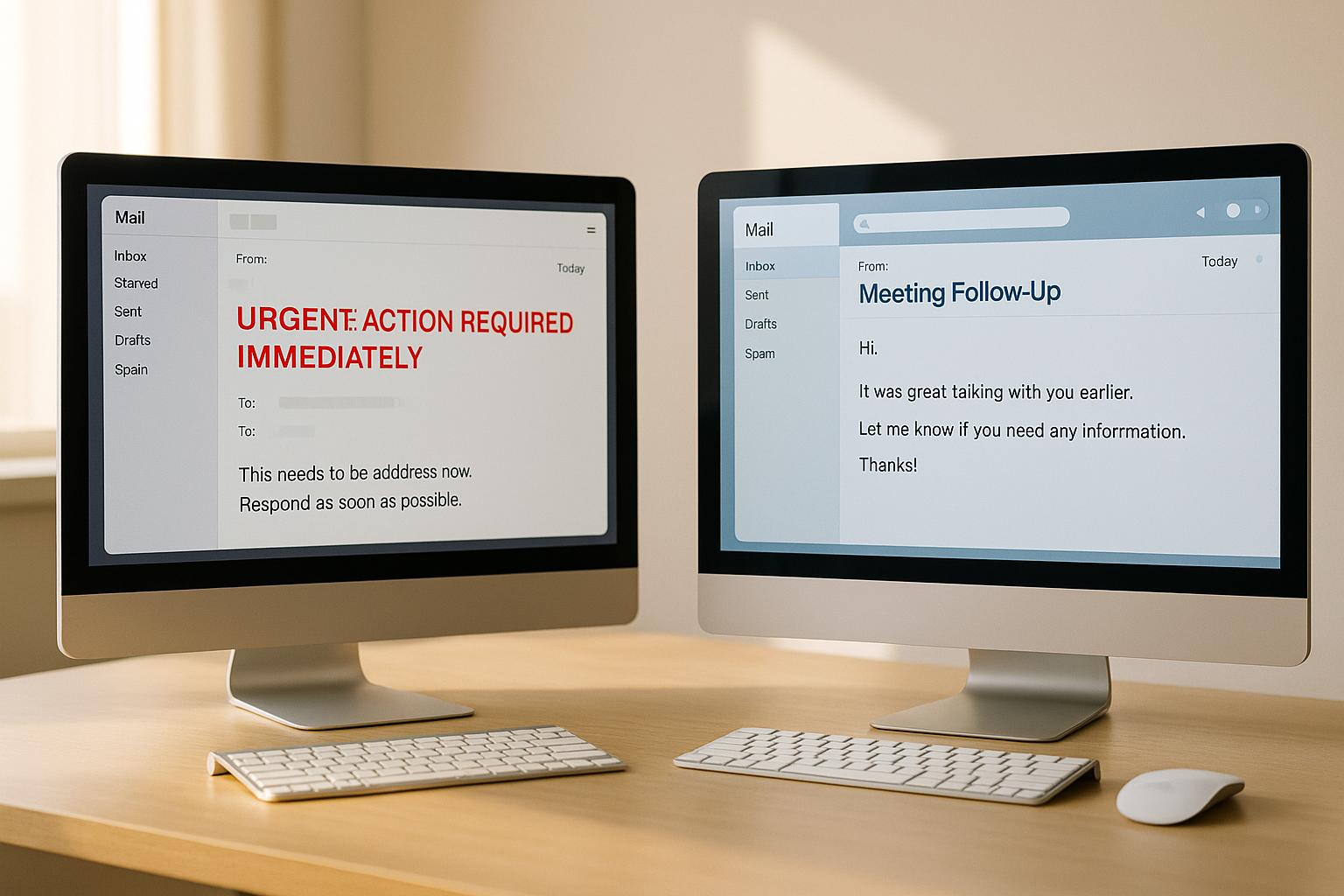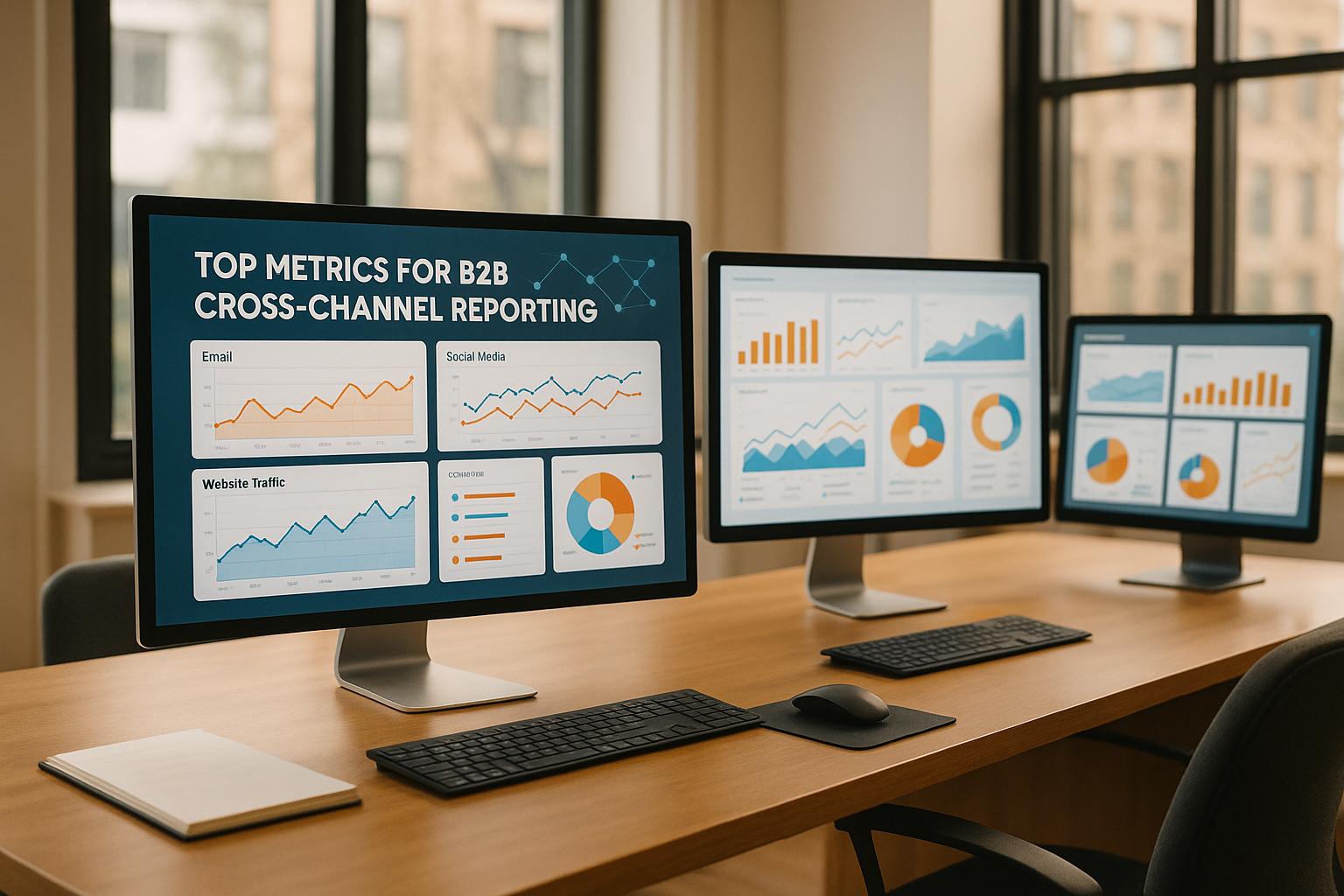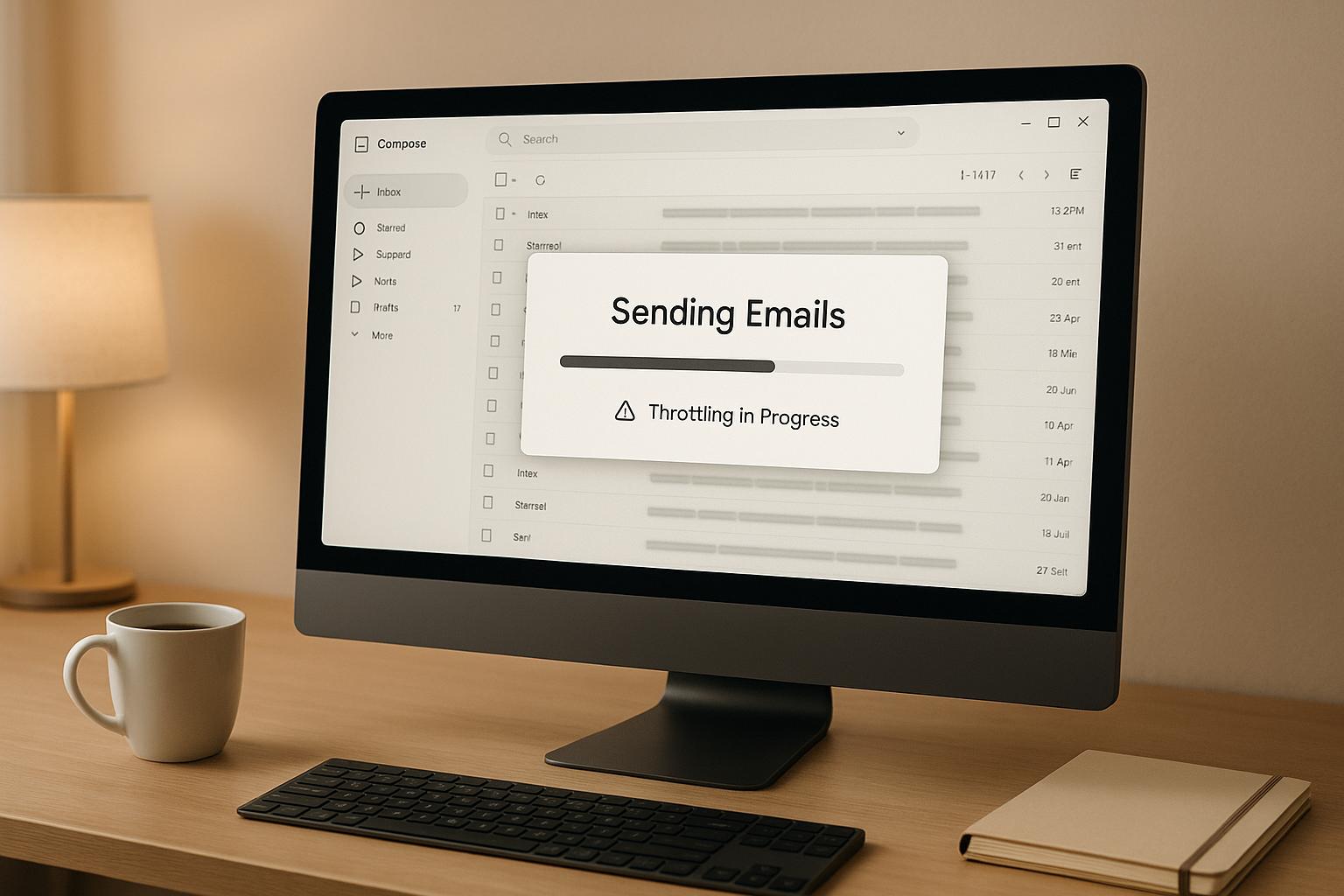Trigger-based email campaigns are automated emails sent based on specific customer actions, like signing up or abandoning a cart. They outperform traditional emails with higher open and click-through rates by delivering timely, personalized messages. Here’s a quick overview of the 7 types:
- Welcome Emails: Engage new subscribers immediately with a warm introduction and clear next steps.
- Abandoned Cart Emails: Recover up to 20% of lost sales by reminding customers about items left in their cart.
- Product Recommendation Emails: Use browsing or purchase history to suggest relevant products.
- Purchase Confirmation Emails: Reassure buyers with order details and tips, building trust.
- Reactivation Emails: Re-engage inactive users with tailored offers or updates.
- Birthday/Anniversary Emails: Celebrate milestones with personalized rewards or discounts.
- New Feature Announcement Emails: Inform users about updates with clear benefits and simple instructions.
Each campaign type uses automation and personalization to improve engagement and conversions. Want to get started? Choose an email platform with strong automation and analytics to track your results.
Email Marketing for Beginners: Triggered Emails
1. Welcome Emails for New Subscribers
Welcome emails are your first chance to connect with new subscribers, introducing them to your brand and setting clear expectations. They play a key role in creating a strong starting point for ongoing engagement.
Take Buffer's welcome email as an example. It introduces their browser extension, offers simple getting-started instructions, and highlights customer support - leaving a solid first impression [1]. The best welcome emails are sent right away, clearly explain the value subscribers will get, and encourage action with a clear next step.
Here’s a quick look at how different types of welcome emails perform:
| Email Type | Average Open Rate | Best Timing | Key Feature |
|---|---|---|---|
| Simple Welcome | 50-60% | Immediate | Brand introduction |
| Welcome + Discount | 70-80% | Within 1 hour | Special offer |
| Welcome Series | 45-55% | Over 3-5 days | Educational content |
To get the most out of your welcome emails, focus on personalized content and choose an email platform with strong automation and scheduling features. By nailing this first interaction, you’re setting the stage for deeper engagement, like following up on abandoned carts or other customer actions.
2. Abandoned Cart Emails to Recover Sales
Abandoned cart emails can recover up to 20% of lost sales by reaching out to customers who leave items in their shopping carts. The key is a well-timed sequence: send a polite reminder within 1–2 hours, follow up 24 hours later with social proof to highlight the product's value, and, by 48–72 hours, create urgency with a limited-time discount.
Personalization is crucial for these emails to work. Include the customer's name, the specific items they left behind, and clear product images. Add a strong call-to-action (CTA) that takes them directly back to their cart. With the right email platform, you can automate these messages to ensure they’re timely and tailored.
The results speak for themselves: abandoned cart emails see average open rates of 45%, click-through rates of 6.76% in the SaaS industry, and conversion rates four times higher than standard promotional emails. To maximize success, start by highlighting the product's value in the first email and save discounts for later follow-ups. This approach avoids encouraging customers to abandon carts just to get a deal.
Experiment with subject lines, content, and CTAs to see what resonates most with your audience. Keep an eye on metrics like open rates, clicks, and recovered revenue to fine-tune your approach. If you’re looking for tools, the Email Service Business Directory is a great resource for finding platforms with strong automation and personalization features.
Besides recovering lost sales, trigger-based emails can also increase engagement through personalized recommendations - more on that in the next section.
3. Product Recommendation Emails
Product recommendation emails use customer activity data to send tailored suggestions, making them far more engaging and effective than generic mass emails. These automated emails are triggered by specific actions, helping you connect with customers at just the right moment in their journey.
A great example? Kipling increased sales by targeting price-sensitive customers with discounted luggage recommendations. By analyzing behavior, such as interest in travel bags, they crafted highly targeted and successful campaigns.
Key triggers for these emails include browsing history, previous purchases, and search activity. To make your recommendations count:
- Send emails shortly after customer interactions to stay relevant.
- Suggest 3-5 products that closely match the customer’s interests.
- Use high-quality images and clear, actionable buttons.
The magic lies in the real-time data. Tools that dynamically update email content based on customer behavior ensure your suggestions stay fresh and aligned with their preferences. Keep an eye on metrics like conversion rates and revenue to gauge how well your campaigns are working.
When setting up these campaigns, choose automation tools designed for advanced personalization. The Email Service Business Directory is a helpful resource for finding platforms that specialize in behavioral targeting.
While recommendation emails shine by delivering tailored content, other campaigns, like purchase confirmations, focus on building trust and enhancing customer satisfaction. Each type plays a role in creating a well-rounded email strategy.
4. Purchase Confirmation Emails
Purchase confirmation emails play a crucial role in validating transactions and reassuring customers. They confirm the purchase while also serving as a chance to strengthen customer trust and loyalty. These automated emails are sent immediately after a purchase, providing key order details and reinforcing the buyer's decision.
What to Include in Purchase Confirmation Emails:
- Clear order and payment details
- Shipping and tracking information
- Contact details for customer support
- Estimated delivery date
For example, Apple’s well-designed confirmation emails boast a 78% open rate, while Nike reduces product-related support queries by 12% by adding personalized care tips to their messages.
How to Improve Your Confirmation Emails
To make your confirmation emails more effective:
- Ensure they’re sent within seconds of the purchase
- Use mobile-friendly designs (since over 60% are opened on phones)
- Provide clear instructions for tracking orders
- Make customer support easy to access
Wayfair sets a great example by including assembly instructions and care guides in their emails, which helps reduce customer anxiety and cuts support tickets by 23%.
Personalizing Purchase Confirmations
With advanced email tools, you can go beyond the basics to create a more tailored experience. Think about adding:
- Assembly instructions or care tips specific to the product
- Links to user manuals or setup guides
- Tips from a community of users
- Support resources related to the purchased item
While the primary goal is to confirm the purchase, adding personalized touches can make customers feel valued and improve their overall experience. This not only builds trust but also lays the groundwork for future engagement.
sbb-itb-6e7333f
5. Reactivation Emails for Inactive Users
Reactivation emails are a great way to reconnect with subscribers who haven’t engaged in a while. These emails aim to spark interest again and are a key part of a trigger-based email marketing strategy.
How to Spot Inactive Users
Platforms like HubSpot and Mailchimp can help identify inactive subscribers by tracking specific behaviors, such as:
- Lack of purchases in the past six months
- No email opens over a three-month period
- No visits to your website or account logins
- Abandoned carts without follow-up actions
Structuring Reactivation Campaigns
Successful reactivation campaigns often follow a timeline like this:
| Timing | Content Type | Average Response Rate |
|---|---|---|
| 3 months inactive | Friendly reminder with updates | 4.2% |
| 6 months inactive | Special discount or promotion | 5.8% |
| 9 months inactive | Final effort with a premium offer | 3.1% |
These targeted emails tend to perform better than standard newsletters, boasting an average click-through rate of 6.76%, compared to 2.14% for regular email campaigns [2].
Personalization Tips
To make your reactivation emails stand out, consider adding:
- References to Past Purchases: Mention items they’ve bought and recommend similar products.
- Behavior-Based Suggestions: Highlight products or services they’ve browsed before.
- Tailored Discounts: Offer deals based on their preferences or purchase history.
Tracking Campaign Success
Evaluate the effectiveness of your reactivation emails by monitoring metrics such as open rates, click-through rates, conversions, and revenue generated from reactivated users.
For the best results, combine these emails with other triggered campaigns, ensuring the timing and messaging are on point. Specialized email marketing platforms from the Email Service Business Directory can help automate and fine-tune your approach.
While reactivation emails aim to win back inactive users, don’t overlook milestone campaigns like birthday emails, which can strengthen relationships with your active subscribers.
6. Birthday and Anniversary Emails
Milestone campaigns, like birthday and anniversary emails, celebrate moments that matter to your customers. These automated messages often perform better than standard promotional emails, helping to create a personal connection that boosts engagement.
Setting Up Milestone Campaigns
To run successful milestone campaigns, you need to gather the right data and set up automation:
| Milestone Type | Data Needed |
|---|---|
| Birthday | Date of birth |
| Purchase Anniversary | First purchase date |
| Account Creation | Sign-up date |
Why Personalization Matters
Birthday and anniversary emails tend to see higher engagement rates, with personalized subject lines increasing open rates by 26%. Here's how you can make them stand out:
- Custom Rewards: Offer time-sensitive deals or discounts tied to the occasion.
- Personalized Content: Use past purchase history or preferences to tailor the message.
- Exclusive Perks: Give customers special benefits available only during these milestones.
Implementation Tips
To get the most out of your milestone campaigns:
- Set up and test automated triggers ahead of time.
- Provide reasonable redemption periods, such as 1-2 weeks.
- Track performance metrics to fine-tune timing and offers.
Staying Compliant
When working with milestone campaigns, it's important to prioritize privacy and follow regulations:
- Obtain clear consent before collecting personal data.
- Make opting out simple and hassle-free.
- Adhere to data protection laws.
- Store customer information securely.
Using the right email platform can simplify the process while ensuring compliance. Many tools in the Email Service Business Directory offer features designed for milestone-based automation, making execution easier.
In addition to personal milestones, consider using trigger-based emails to share updates or announcements that keep your customers engaged with your brand.
7. New Feature Announcement Emails
Emails announcing new features keep users informed and engaged with your product. These targeted campaigns encourage users to explore updates while highlighting your product's evolution.
Timing and Triggers
Plan your announcements carefully by considering:
- Release timelines
- User behavior and activity
- The complexity of the new feature
- Specific needs of different user groups
Crafting Effective Announcements
A strong feature announcement email includes:
- A clear, attention-grabbing subject line
- A brief overview of the new feature and its benefits
- Actionable steps with visuals or tutorials to guide users
- A prominent call-to-action button encouraging immediate engagement
This structure ensures users quickly understand the feature and know how to use it.
Personalization Tips
Leverage user engagement data to prioritize and customize announcements. For example, provide detailed technical insights for advanced users or simplified instructions for beginners. Tailored messaging resonates better with each audience segment.
Measuring Performance
Evaluate the success of your emails by tracking:
- Open rates (target: 25-35%)
- Click-through rates (target: 15-25%)
- Feature adoption rates (target: 10-20%)
These metrics help refine future campaigns and assess user interest.
Best Practices for Implementation
To make your announcements impactful:
- Test the feature with beta users before the full rollout
- Use visuals to demonstrate functionality
- Offer easy-to-follow guides
- Provide links to support resources
- Follow up with helpful tips to boost adoption
Mistakes to Avoid
When crafting these emails, steer clear of:
- Overloading users with excessive technical jargon - focus on practical benefits
- Sending too many announcements in a short time
- Leaving out clear next steps for users
Stick to a consistent schedule that aligns with your product updates, and respect user preferences for communication frequency.
Finally, automation tools can help segment your audience and deliver personalized emails based on user behavior. This ensures that each recipient gets information relevant to their needs and interests.
How to Pick the Right Email Marketing Platform
Choosing the right email marketing platform is crucial for the success of trigger-based email campaigns. The platform you select will impact how effectively you can automate, personalize, and scale your campaigns. Here's a guide to help you make the right choice.
Key Features to Look For
When comparing platforms, prioritize these features:
- Automation & Personalization: Tools that allow behavior-based campaigns, dynamic content, and audience segmentation.
- Integration: Compatibility with tools like CRMs and e-commerce platforms to streamline your workflow.
- Scalability: The ability to grow with your business, handling larger contact lists and more complex workflows.
- Analytics: Detailed insights into campaign performance, helping you track ROI and optimize strategies.
Comparing Platforms
Use this table to evaluate potential platforms:
| Feature Category | Key Capabilities |
|---|---|
| Automation | Workflow management, both basic and advanced |
| Integration | Connections with CRMs, APIs, and other tools |
| Analytics | Performance tracking and ROI insights |
| Deliverability | Tools for email authentication and inbox placement |
What to Consider for Performance
When assessing platforms, keep these performance factors in mind:
Deliverability
Choose a platform with strong email authentication and compliance tools to ensure your emails land in inboxes, not spam folders.
Analytics
Look for platforms that provide in-depth reporting, including:
- Open and click-through rates
- Conversion tracking
- A/B testing tools
Support
Reliable support can make or break your experience. Opt for platforms that offer:
- Fast, responsive customer service
- Clear and thorough documentation
- Help with onboarding and implementation
For a detailed comparison of platforms tailored to specific needs and budgets, check out the Email Service Business Directory (emailservicebusiness.com).
With the right platform, you’ll be well-equipped to run effective trigger-based campaigns, boosting engagement and driving conversions.
Conclusion
Using the right email marketing platform allows businesses to tap into the potential of trigger-based campaigns, delivering timely, personalized messages that connect with customers at key moments in their journey. These campaigns often outperform traditional methods by focusing on relevance and timing.
Different types of trigger-based campaigns play unique roles in the customer experience. For instance, welcome emails help set a positive tone from the start, abandoned cart emails recover lost sales opportunities, and personalized recommendations keep customers engaged over time. When executed well, these automated messages build stronger connections with your audience.
Selecting an email platform with robust automation and personalization features is critical for success. Look for tools that offer seamless integration, scalability, and advanced automation options to help you design and manage campaigns effectively.
Keep an eye on metrics like open rates and conversions to fine-tune your efforts. By combining automation tools with a customer-focused approach, you can create campaigns that drive engagement and deliver measurable outcomes. Whether you're just starting with welcome emails or diving into more advanced behavioral triggers, the strategies in this guide can help you unlock better results from your email marketing efforts.


